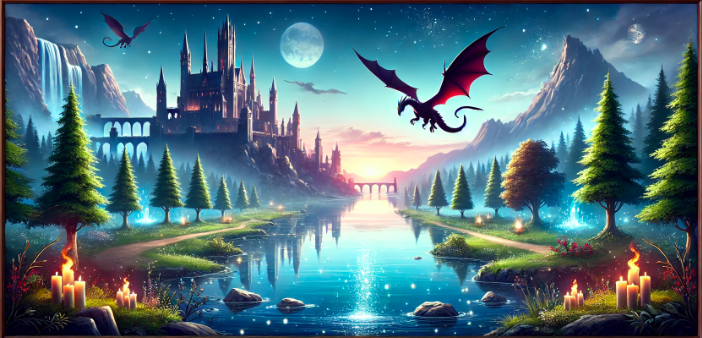Crafting magical worlds in fantasy writing is an art that transports readers to realms of wonder, adventure, and limitless imagination. This article delves into the intricacies of building fantasy worlds in literature, a fundamental aspect that distinguishes the genre and captivates audiences. From the vast landscapes of Middle Earth to the enchanting halls of Hogwarts, the ability to create a believable and immersive fantasy world is what often sets apart a good fantasy story from a great one.
World-building is more than just creating a backdrop for the story; it’s about constructing a living, breathing environment that shapes the narrative and influences the characters. A well-crafted fantasy world provides a sense of place and reality that allows readers to fully engage with the story. It establishes the rules, cultures, and histories that give depth to the narrative, making the fantastical elements feel plausible and the characters’ journeys meaningful.
Key concepts in crafting magical worlds include the development of a coherent and consistent magic system, the establishment of unique societal structures, and the integration of detailed lore and history. A magic system, whether it’s the soft magic of Tolkien’s works or the more rigidly defined systems seen in Brandon Sanderson’s novels, is essential in defining the boundaries and possibilities within the world. The fantasy world itself must be meticulously developed, from its geography and ecology to its political and social dynamics.
In this article, we will explore various aspects of world-building, including the creation of magic systems, the importance of cultural and historical context, and techniques for integrating these elements seamlessly into your narrative. We will also discuss common pitfalls to avoid and provide practical tips for aspiring fantasy writers. By the end of this journey, you will have a deeper understanding of how to craft a magical world that not only serves as a compelling setting for your story but also enriches the overall reading experience.
What Makes a Fantasy World
A fantasy world is a meticulously crafted universe that exists beyond the boundaries of our reality, where the laws of nature and society are governed by imagination and creativity. Fantasy elements, such as magical creatures and supernatural phenomena, contribute to the uniqueness of these worlds by blending the fantastical with the familiar. These worlds are populated with unique landscapes, magical creatures, and distinct cultures, all designed to transport readers to a place where anything is possible. The significance of a fantasy world lies in its ability to provide an escape from the mundane, offering a canvas for epic adventures, complex characters, and thought-provoking themes.
Fantasy worlds are often contrasted with other genres, particularly science fiction. While both genres involve speculative elements, the core difference lies in their approach to the unknown. Science fiction generally roots its speculative elements in scientific principles and plausible future technologies, creating worlds that extend or extrapolate from our current understanding of science. In contrast, fantasy worlds are often based on magical or supernatural elements that defy real-world logic. This distinction allows fantasy writers to create entirely new rules and systems, from the mystical realms of Middle Earth to the spellbinding universe of Harry Potter.
Middle Earth, created by J.R.R. Tolkien, is one of the most iconic fantasy worlds. It is a land rich with history, diverse races, and epic battles between good and evil. Tolkien’s detailed world-building includes languages, mythology, and a deep sense of place that immerses readers fully into the narrative. Similarly, the Harry Potter series by J.K. Rowling presents a hidden magical society within the real world, complete with its own rules, institutions, and culture, making the magical elements feel both wondrous and believable.
Star Wars, while often categorized as science fiction due to its space setting, also contains many elements typical of fantasy, such as the Force, a mystical energy that grants characters extraordinary abilities. The richly developed universe of Star Wars includes planets with diverse ecosystems, intricate political systems, and a deep lore that engages fans in much the same way as traditional fantasy worlds.
The importance of a clear and immersive setting in fantasy cannot be overstated. A well-defined setting grounds the story, giving readers a sense of place and context that enhances their engagement. It allows them to visualize the environment, understand the stakes, and connect with the characters on a deeper level. An immersive setting provides consistency and coherence, ensuring that the fantastical elements feel natural within the story’s framework.
Creating an immersive setting involves more than just describing scenery. It requires the development of cultural norms, societal structures, and historical background that influence the characters and plot. For instance, the feudal system in George R.R. Martin’s Westeros (from “A Song of Ice and Fire” series) shapes the political intrigue and conflicts that drive the narrative. The setting must also be dynamic, capable of evolving with the story and responding to the characters’ actions.
Elements of a Fantasy World
Creating a compelling fantasy world involves weaving together several key components, each contributing to the richness and believability of the setting. These elements include geography, culture, and history, all of which play vital roles in shaping the narrative and the characters’ experiences. A good fantasy world should be seamless and effortless, almost like magic, to enhance the storytelling and not detract from the action.
Geography: The physical landscape of a fantasy world provides the foundation for its story. Geography encompasses the natural features of the world, such as mountains, rivers, forests, and deserts, as well as man-made structures like cities, castles, and roads. A well-defined geography not only helps in setting the scene but also influences the plot and the characters’ journeys. For instance, J.R.R. Tolkien’s Middle Earth features diverse landscapes that are integral to the story, from the idyllic Shire to the treacherous Mordor.
Culture: Culture defines the customs, traditions, languages, and beliefs of the people inhabiting the fantasy world. It shapes the characters’ behavior, social interactions, and conflicts. Different races or factions within a fantasy world often have distinct cultures, adding depth and variety to the narrative. In J.K. Rowling’s Harry Potter series, the wizarding world has its own unique culture, with traditions like the Sorting Hat ceremony and Quidditch matches, which enrich the story and provide a sense of authenticity.
History: A rich backstory adds layers of depth to a fantasy world, making it feel lived-in and real. History includes myths, legends, and significant events that have shaped the world and its inhabitants. This historical context can influence the current events of the story and provide motivation for the characters. George R.R. Martin’s “A Song of Ice and Fire” series is renowned for its intricate history, with past wars, dynasties, and betrayals all playing crucial roles in the unfolding narrative.
Societal Structures, Economies, and Politics: The organization of society, economic systems, and political structures are crucial for creating a believable and complex world. Societal structures might include feudal hierarchies, guild systems, or tribal organizations. Economic systems determine how wealth and resources are distributed, influencing the plot and character dynamics. Political intrigue and power struggles often drive the narrative in fantasy stories. In Patrick Rothfuss’s “The Kingkiller Chronicle,” the societal and political structures of different regions add complexity and realism to the story.
Examples of Unique and Interesting Fantasy Settings: Settings like the floating islands of Terragrigia in Peter V. Brett’s “Demon Cycle” series or the steampunk city of New Crobuzon in China Miéville’s “Perdido Street Station” offer readers a blend of familiar and fantastical elements, making the worlds intriguing and immersive.
Balancing Realism with Imagination: To create a believable fantasy world, it is essential to balance realism with imagination. While fantasy allows for creative freedom, grounding the world in realistic details makes it more relatable to readers. This can be achieved by establishing clear rules for how magic works, creating consistent cultural practices, and developing logical geographical features. By blending the fantastical with the plausible, writers can craft worlds that captivate and resonate with their audience.
Creating Magic Systems
A well-crafted magic system is a cornerstone of many fantasy worlds, providing the framework for the fantastical elements within the story. Magic systems can be broadly categorized into two types: soft magic and hard magic. Understanding the nuances of each type, the importance of rules and limitations, and examples of effective magic systems can help writers develop coherent and engaging magic systems in their own stories. For instance, incorporating elements like dark magic, which often involves a war between light and dark magic within a parallel world, can add complexity and conflict to a fantasy world.
Definition and Types of Magic Systems
Soft Magic: Soft magic systems are characterized by their mysterious and undefined nature. They often serve as a backdrop to the story, enhancing the sense of wonder without detailed explanations of how they work. Soft magic is used to create an atmosphere of the unknown, allowing for flexibility and creativity in its application. Examples of soft magic include the magic in J.R.R. Tolkien’s Middle Earth, where the specifics of magic are rarely explained, maintaining an air of mystique and awe.
Hard Magic: Hard magic systems, on the other hand, are defined by their clear rules and limitations. These systems are explicitly explained, providing a structured and logical framework for magic use within the story. Hard magic allows readers to understand the capabilities and constraints of magic, creating a sense of predictability and fairness. Brandon Sanderson’s works, particularly his “Mistborn” series, are prime examples of hard magic systems. Sanderson’s “Allomancy” involves specific metals granting distinct powers, with clearly outlined rules and limitations.
Importance of Rules and Limitations in Magic Use
Rules and limitations are crucial in a magic system because they prevent magic from becoming a deus ex machina that can solve any problem without effort or consequence. By setting boundaries on what magic can and cannot do, writers create tension and stakes within their stories. These constraints force characters to think creatively and make meaningful decisions, enhancing the narrative’s depth.
Moreover, limitations can stem from various sources, such as the need for specific resources (e.g., magical ingredients or objects), physical or mental tolls on the user, or societal restrictions. For instance, in “The Name of the Wind” by Patrick Rothfuss, the protagonist’s use of magic, known as “sympathy,” requires a significant understanding of the natural laws and exacting mental focus, providing a realistic and challenging framework for magical practice.
Examples of Effective Magic Systems in Literature
Brandon Sanderson’s laws of magic are highly regarded for their clarity and effectiveness. His first law states that an author’s ability to solve conflict with magic is directly proportional to how well the reader understands said magic. This principle emphasizes the need for transparent rules in creating engaging and satisfying magical resolutions.
In Leigh Bardugo’s “Grisha” trilogy, the magic system, known as “Small Science,” is based on the manipulation of matter at a molecular level. Each type of Grisha has specific powers, such as manipulating elements or healing, with well-defined limits and costs. This structured approach to magic adds layers of complexity and intrigue to the story.
Developing a Coherent and Engaging Magic System
To develop a coherent and engaging magic system, start by defining the source of magic: where it comes from, how it works, and who can use it. Consider the following steps:
1. Set Clear Rules and Limitations: Establish what magic can and cannot do. Define the costs, whether they be physical, mental, or material.
2. Consistency: Ensure that the magic system remains consistent throughout the story. Inconsistencies can break immersion and undermine the story’s internal logic.
3. Integration with World-Building: Integrate the magic system into the broader world. How does magic affect society, politics, and everyday life? What are the cultural attitudes towards magic?
4. Character Interaction: Show how characters interact with and are affected by the magic system. This interaction can reveal much about both the characters and the world.
By thoughtfully developing a magic system with clear rules and limitations, integrating it seamlessly into the world, and maintaining consistency, writers can create a magic system that not only enhances their story but also captivates and engages their readers.
Building Depth in Your Fantasy World
Building a fantasy world that feels real and immersive requires more than just a compelling setting; it demands depth and complexity. A fantasy writer faces unique challenges in creating a detailed and immersive world, including the creation of rich lore, unique languages, and captivating myths. Consistency is crucial to avoid plot holes and maintain the integrity of the world. Characters’ interactions with their environment further enhance the believability of the world, and thoughtful world-building significantly impacts the plot and themes of the story.
Techniques for Adding Depth: Lore, Languages, Myths
Lore: Lore refers to the body of knowledge, traditions, and stories that define a world’s history and culture. Creating detailed lore involves developing a backstory that includes significant events, legends, and traditions that shape the current state of the world. For example, in J.R.R. Tolkien’s Middle Earth, the lore is deeply interwoven with the narrative, from the ancient wars of the Silmarillion to the myths surrounding characters like Beren and Lúthien. These stories add layers of history that make the world feel ancient and lived-in.
Languages: Crafting unique languages can greatly enhance the authenticity of a fantasy world. Tolkien’s Elvish languages (Sindarin and Quenya) and George R.R. Martin’s Dothraki and Valyrian in “A Song of Ice and Fire” series are prime examples. Languages can convey cultural nuances, social hierarchies, and historical contexts, adding a rich layer of realism. Even creating a few key phrases or naming conventions can significantly enrich the world.
Myths: Myths and legends serve as the spiritual and cultural backbone of a society. They provide insight into the values, fears, and aspirations of the world’s inhabitants. Incorporating myths into your fantasy world can reveal much about its people and their worldview. For instance, the myths of the Old Gods and the Seven in “A Song of Ice and Fire” reflect the diverse religious beliefs that influence the series’ characters and conflicts.
Importance of Consistency and Avoiding Plot Holes
Consistency is critical in maintaining the credibility of a fantasy world. Inconsistencies and plot holes can break the immersion, causing readers to question the logic of the world. To avoid this, writers should establish clear rules for how the world operates and adhere to them. Keeping a detailed world-building bible can help track important details, ensuring continuity throughout the narrative. This includes maintaining consistency in the geography, cultural practices, and magical rules.
Role of Characters and Their Interactions with the World
Characters are the lens through which readers experience the fantasy world. Their interactions with the environment, society, and magical elements bring the world to life. By showing how characters navigate and are influenced by their surroundings, writers can reveal the world’s complexities and nuances. For example, how a character reacts to encountering a mythical creature or navigating political intrigue can provide insights into both the character and the world.
The Impact of World-Building on the Story’s Plot and Themes
Effective world-building can profoundly impact the plot and themes of a story. A well-developed world provides a rich backdrop that can drive the plot forward and enhance thematic depth. The unique challenges and conflicts arising from the world’s characteristics can shape the story’s direction and the characters’ arcs. For instance, the oppressive regime in Suzanne Collins’s “The Hunger Games” series creates a setting where themes of rebellion, survival, and freedom are explored through the protagonist’s journey.
Moreover, the world’s culture, politics, and history can influence the story’s themes, adding layers of meaning and resonance. In N.K. Jemisin’s “The Broken Earth” trilogy, the world’s geological instability and societal structures underpin themes of power, discrimination, and resilience, creating a narrative deeply intertwined with its setting.
In conclusion, building depth in your fantasy world involves developing rich lore, languages, and myths, maintaining consistency, and ensuring that characters’ interactions with their environment enhance the narrative. Thoughtful world-building not only makes the setting more immersive but also enriches the plot and themes, creating a compelling and unforgettable story.
Your Publishing Journey Awaits – Start NowFantasy Stories: Bringing the World to Life
Crafting a vivid and immersive fantasy world is only part of the journey; the real challenge lies in seamlessly integrating this world into the narrative. Successful world-building must enhance the story without overwhelming it, ensuring that the setting serves as a dynamic backdrop for the characters’ adventures and growth. In fantasy genres, world-building often involves creating entirely new realms or integrating fantastical elements into real-world settings, as seen in Guillermo Del Toro’s Pan’s Labyrinth, which introduces a fantasy realm within the historical context of WWII.
Integration of World-Building into the Narrative
World-building should be woven into the fabric of the narrative rather than presented in large, expository chunks. This can be achieved by revealing the world through the characters’ experiences, actions, and dialogues. Subtle details about the environment, culture, and history can be introduced organically as the plot unfolds. For instance, in Patrick Rothfuss’s “The Name of the Wind,” the intricate details of the world are gradually unveiled through the protagonist’s journey, making the setting feel naturally integrated and engaging.
The Relationship Between Characters and the World They Inhabit
Characters’ interactions with their world are crucial in bringing the setting to life. Their backgrounds, beliefs, and choices should reflect the unique aspects of their environment. For example, a character from a harsh desert world might have a different outlook and skill set than one from a lush, magical forest. These interactions not only make the characters more believable but also provide readers with a deeper understanding of the world. In N.K. Jemisin’s “The Broken Earth” trilogy, the characters’ abilities and struggles are directly influenced by the geological instability of their world, creating a powerful connection between character development and setting.
Examples of Stories Where the Setting Plays a Crucial Role
Many renowned fantasy stories have settings that are integral to their plots. In J.R.R. Tolkien’s “The Lord of the Rings,” Middle Earth is not just a backdrop but a living, breathing world that influences the story at every turn. The journey through diverse regions like the Shire, Rivendell, and Mordor is essential to the narrative, shaping the characters’ experiences and the unfolding of the plot. Similarly, in George R.R. Martin’s “A Song of Ice and Fire,” the political intrigue and conflicts are deeply rooted in the distinct cultures and landscapes of Westeros and Essos, making the setting a crucial component of the story.
Balancing Exposition and Action to Maintain Reader Interest
Maintaining a balance between exposition and action is key to keeping readers engaged. Too much exposition can bog down the narrative, while too little can leave readers confused about the world’s context. Writers should strive to provide just enough detail to keep the world vivid without detracting from the plot’s momentum. One effective technique is to reveal world-building details through action and dialogue. For instance, in J.K. Rowling’s “Harry Potter” series, the magical world is often introduced through Harry’s eyes as he explores new places and encounters magical creatures, allowing readers to learn about the world through his experiences.
Another strategy is to use environmental storytelling, where the setting itself conveys information about the world. Descriptions of weather, architecture, and local customs can all contribute to world-building without lengthy explanations. In Brandon Sanderson’s “Mistborn” series, the ash-covered landscape and metal-based magic system are gradually revealed through the characters’ interactions and challenges, maintaining a balance that keeps the narrative pace brisk.
In summary, bringing a fantasy world to life involves seamlessly integrating world-building into the narrative, ensuring that characters’ interactions with their environment enhance the story. Examples from well-known fantasy works demonstrate how settings can play a crucial role, influencing plots and enriching themes. By balancing exposition and action, writers can create immersive and engaging worlds that captivate readers and drive their stories forward.
Fantasy World-Building with a Coach: Should You Use a Writing Coach?
A writing coach can be an invaluable ally in the process of world-building, particularly for fantasy writers aiming to create immersive, believable settings. They offer guidance that helps you refine your ideas and ensure your world-building serves the narrative. A coach can help you assess whether your magic systems, cultures, and histories are coherent and effectively integrated into the plot, or if they risk overwhelming your readers with unnecessary details.
Beyond structural advice, writing coaches can also provide feedback on character interactions with the world. As you flesh out the environments your characters inhabit, a coach will help ensure that these interactions feel natural and true to the world you’ve created, making the setting a dynamic element of your storytelling.
Working with a book writing coach allows you to navigate common pitfalls—such as overcomplicating your world or losing sight of the story’s needs—while providing you with expert insight on pacing, narrative flow, and character development. Their support helps elevate your world-building to the next level, ensuring it’s as compelling and seamless as the adventure you’re creating.
Common Pitfalls in World-Building
World-building is a vital component of fantasy writing, but it comes with its own set of challenges. Common pitfalls include overcomplicating the world with unnecessary details, ignoring the story’s needs, and focusing too much on the setting. By understanding these pitfalls, writers can create worlds that enhance their narratives rather than detract from them.
Overcomplicating the World with Unnecessary Details
One of the most frequent mistakes in world-building is overloading the reader with excessive details. While it’s important to create a rich and immersive world, bombarding readers with intricate histories, elaborate customs, or overly detailed maps can be overwhelming. These details can bog down the narrative and distract from the main story. Instead, focus on the aspects of the world that directly impact the plot and characters, revealing other details gradually as needed to support the story.
Ignoring the Story’s Needs and Focusing Too Much on the Setting
Another common pitfall is becoming so engrossed in creating the world that the story and characters are neglected. A meticulously crafted world is pointless if it doesn’t serve the narrative. World-building should always be in service to the story, providing a backdrop that enhances the plot and deepens character development. Remember that the primary purpose of world-building is to support the narrative, not to overshadow it.
Tips for Avoiding Common Mistakes
- Prioritize Relevance: Include only those details that are relevant to the plot, characters, or themes. Ask yourself if a piece of information advances the story or helps readers understand the world better.
- Integrate Seamlessly: Weave world-building elements into the narrative naturally, through character actions, dialogue, and settings. Avoid lengthy expository passages that disrupt the story’s flow.
- Maintain Balance: Strike a balance between world-building and storytelling. Ensure that world-building elements enhance rather than hinder the narrative pace.
- Be Consistent: Consistency is key. Ensure that the world’s rules, cultures, and histories are consistent throughout the story to avoid confusing the reader and breaking immersion.
Ensuring the World Serves the Story and Characters
Ultimately, the world you build should serve as a stage for your story and characters. It should provide context, conflict, and richness without overshadowing the narrative. Focus on how the world influences your characters’ motivations, decisions, and growth. By keeping the story and characters at the forefront, you can ensure that your world-building supports and enhances the narrative, creating a cohesive and engaging fantasy world.
In summary, effective world-building requires a balance between detail and narrative. Avoid overcomplicating with unnecessary details, ensure the world serves the story, and integrate world-building elements seamlessly to create a rich, immersive, and supportive backdrop for your fantasy tale.
The Magic of World-Building in Fantasy Writing
Crafting magical worlds in fantasy writing is essential for creating immersive and captivating stories. These richly developed settings provide the backdrop for epic adventures, complex characters, and engaging plots. Writers are encouraged to explore and develop their own unique settings, balancing detail with narrative to enhance their storytelling. The creative process of world-building not only enriches the story but also profoundly impacts readers, transporting them to new realms of imagination and wonder. Embrace the challenge of creating your own fantasy world, and let your imagination bring it to life for your readers.








